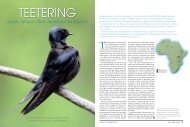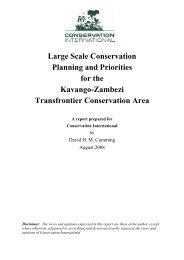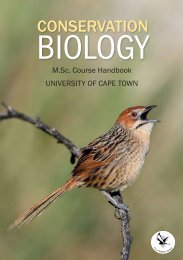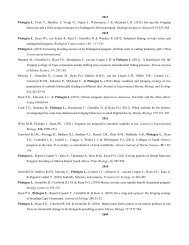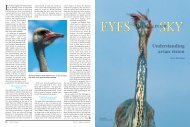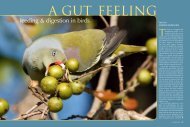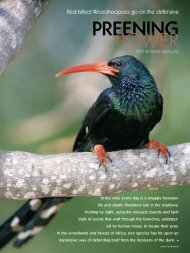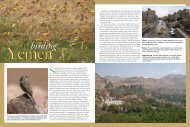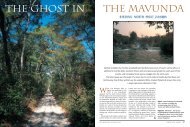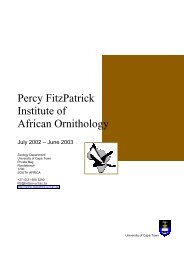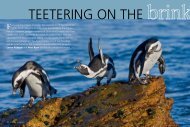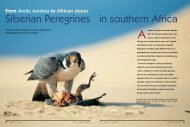KNOWLEDGE FOR conservation - Percy FitzPatrick Institute of ...
KNOWLEDGE FOR conservation - Percy FitzPatrick Institute of ...
KNOWLEDGE FOR conservation - Percy FitzPatrick Institute of ...
You also want an ePaper? Increase the reach of your titles
YUMPU automatically turns print PDFs into web optimized ePapers that Google loves.
knowledge for<br />
<strong>conservation</strong><br />
The <strong>Percy</strong> <strong>FitzPatrick</strong> <strong>Institute</strong> and ground-hornbills<br />
keith begg<br />
Unlike other hornbills, the ground-hornbill<br />
does not have a sealed nest cavity.<br />
Ground-hornbills are extremely longlived<br />
and they are extremely slow<br />
breeders, apparently producing on<br />
average only one surviving <strong>of</strong>fspring per<br />
decade. Very slow reproduction is a lifehistory<br />
trait that predisposes species to<br />
<strong>conservation</strong> problems. It is easy to be fooled<br />
by regular sightings <strong>of</strong> adult birds when a<br />
species or population may already be slipping<br />
towards extinction, and it is therefore<br />
vital to know what the demographic pr<strong>of</strong>ile<br />
<strong>of</strong> such a species is, and where its greatest<br />
vulnerabilities might lie. This demands sound<br />
knowledge <strong>of</strong> important life-history traits<br />
such as breeding system and longevity.<br />
Researchers from the <strong>Percy</strong> <strong>FitzPatrick</strong><br />
<strong>Institute</strong>, under the direction <strong>of</strong> Morné du<br />
Plessis, are undertaking a long-term study at<br />
the invitation <strong>of</strong> the Association <strong>of</strong> Private<br />
Nature Reserves (APNR), which includes the<br />
Balule, Klaserie, Timbavati and Umbabat<br />
nature reserves. The APNR covers a large<br />
tract <strong>of</strong> privately owned <strong>conservation</strong> land<br />
along the western boundary <strong>of</strong> the Kruger<br />
National Park.<br />
An initial assessment in 2001 by Yuval<br />
Erlich <strong>of</strong> the ground-hornbills in this area<br />
found little evidence <strong>of</strong> successful breeding,<br />
and only four natural nests were known to<br />
exist in an area <strong>of</strong> 150 000 hectares. Over<br />
the subsequent two years, Erlich coordinated<br />
the sculpting and deployment <strong>of</strong> a total <strong>of</strong><br />
30 artificial nest logs.<br />
Breeding success over the following<br />
seasons seemed low, with one, two and<br />
three fledglings produced in the 2002, 2003<br />
and 2005 breeding seasons respectively.<br />
However, the 2004 breeding season proved<br />
to be a bumper year as 11 ground-hornbill<br />
groups each produced one nestling, nine<br />
<strong>of</strong> which fledged. Most gratifying was that<br />
90 per cent <strong>of</strong> the fledglings had hatched<br />
from artificial nest logs. This strongly suggests<br />
that a shortage <strong>of</strong> natural nest sites is<br />
limiting the local productivity <strong>of</strong> this species.<br />
Data from the past five breeding seasons<br />
clearly demonstrate that the breeding success<br />
<strong>of</strong> ground-hornbills is erratic, highlighting<br />
the importance <strong>of</strong> having stable breeding<br />
groups in situ to capitalise on the occasional<br />
year in which environmental conditions<br />
favour successful breeding.<br />
Although 10 young have fledged over five<br />
breeding seasons from the APNR, only two<br />
are known to have survived their first year.<br />
This seems a particularly unforgiving gauntlet<br />
that young birds must run. It is a priority<br />
to establish why survivorship <strong>of</strong> first-year<br />
birds is so low, and whether there is any way<br />
in which this can be improved.<br />
Because ground-hornbill territories are<br />
so large (up to 10 000 hectares), finding a<br />
group can be akin to looking for needles<br />
in a haystack. Even well-known hornbill<br />
groups sometimes seemingly disappear<br />
during the non-breeding season, only to be<br />
found intact some weeks or even months<br />
later. This can lead to costly and seemingly<br />
futile research effort... not to mention the<br />
frustration!<br />
Fitztitute researchers are currently making<br />
an effort to capture adult ground-hornbills<br />
in order to get an individually ringed<br />
population study started. A primary aim<br />
<strong>of</strong> this is to understand individual survival.<br />
A small radio transmitter is attached to one<br />
bird in each social group, so as to enable researchers<br />
to locate the groups. The next step<br />
will be to deploy GPS transmitters which will<br />
give an accurate fix <strong>of</strong> the group at hourly<br />
intervals and thus allow us to understand<br />
how the birds use their large territories,<br />
and hence perhaps to understand why the<br />
territories are so big. The advantages <strong>of</strong> GPS<br />
transmitters are obvious but, most notably,<br />
they enable accurate information to be gathered<br />
on group movements in relation to the<br />
time <strong>of</strong> year, and on their social environment<br />
as reflected by the composition and size <strong>of</strong><br />
neighbouring groups.<br />
Each breeding season, Fitztitute researchers<br />
also conduct two or three surveys <strong>of</strong> the<br />
known ground-hornbill nests in the Kruger<br />
National Park: first during egg-laying, then<br />
during the mid-nestling phase and, finally, to<br />
ring the nestlings immediately prior to fledging.<br />
Over time, an individually identifiable<br />
population will be established that will play<br />
a vital role in providing accurate knowledge<br />
<strong>of</strong>, for example, the age at first breeding and<br />
the comparative survival <strong>of</strong> the age and sex<br />
classes. The clearer the demographic picture<br />
<strong>of</strong> a species becomes, the more confidently<br />
one can develop proactive, in situ <strong>conservation</strong><br />
action plans. In short, sound knowledge<br />
is vital for sound <strong>conservation</strong>.<br />
Acknowledgements<br />
Yuval Erlich’s drive and dedication were<br />
primarily responsible for the establishment <strong>of</strong><br />
the study in the APNR. There, the Fitztitute<br />
has received tremendous support from the<br />
Exco, the wardens, landowners and numerous<br />
volunteers. DOW Chemicals provides<br />
the project with a vehicle and financial<br />
assistance, as do several tourist lodges in<br />
Timbavati. In the Kruger National Park, much<br />
depends on the backing and encouragement<br />
<strong>of</strong> SANParks researchers and field<br />
managers. We are grateful to them all.<br />
Morné du Plessis<br />
<strong>Percy</strong> <strong>FitzPatrick</strong> <strong>Institute</strong><br />
University <strong>of</strong> Cape Town<br />
On the hunt...<br />
In mid-April 2006, while leading a safari<br />
to the Linyanti/Savuti area in northern<br />
Botswana, guide Lee Whittam captured<br />
the following interaction between Southern<br />
Ground-Hornbills and a flock <strong>of</strong> starlings.<br />
It illustrates the group-hunting technique<br />
employed by this carnivorous hornbill,<br />
which takes most <strong>of</strong> its prey items while<br />
walking slowly in a phalanx.<br />
‘We came across this group <strong>of</strong> groundhornbills<br />
after we had been alerted to their<br />
presence by the mobbing calls <strong>of</strong> several<br />
Burchell’s Starlings. We could distinguish<br />
the ground-hornbills in the long grass easily<br />
enough, but it was more difficult to see<br />
what they were after. After a few seconds it<br />
became evident as a starling made a bid to<br />
escape from the hornbills, only to be chased<br />
down and plucked out <strong>of</strong> the air. The hornbills<br />
were relentless in pursuit <strong>of</strong> the starling,<br />
continuing until they had despatched<br />
it. In the midst <strong>of</strong> the commotion, an African<br />
Fish-Eagle arrived, obviously attracted<br />
by the noise <strong>of</strong> the mobbing starlings –<br />
and by the possibility <strong>of</strong> a free meal. It<br />
waited patiently for its chance and eventually<br />
opportunistically pirated the starling<br />
from the three ground-hornbills.’<br />
The Endangered Wildlife Trust (EWT) launched the Ground Hornbill Working Group in August 2004. The EWT, with its experience<br />
in establishing and running multi-stakeholder Working Groups which address critical <strong>conservation</strong> issues practically and<br />
effectively, established this group to coordinate the wide spectrum <strong>of</strong> ground-hornbill <strong>conservation</strong> activities, conduct field work,<br />
undertake applied research and investigate methods <strong>of</strong> mitigating and reducing the threats facing this species.<br />
In its bid to secure a future for the ground-hornbill, the Working Group aims to ensure the survival <strong>of</strong> the<br />
species’ natural habitats and associated biodiversity by promoting an improved understanding <strong>of</strong> its biology and<br />
ecology, securing viable habitat, and encouraging the participation and cooperation <strong>of</strong> communities and institutions.<br />
For more details, contact L.D. van Essen, Manager Ground Hornbill Working Group, Endangered Wildlife<br />
Trust. Tel. (+27-11) 486 1102; e-mail ldv@ewt.org.za<br />
40 africa’s hornbills africa – birds & birding<br />
august/september 2006<br />
africa’s hornbills 41
A male Southern Yellow-billed Hornbill rests with bill agape, his large bill and casque ridge<br />
separating him from his smaller mate, who is probably sealed into a nearby nest cavity.<br />
skulduggery<br />
Officers <strong>of</strong> the US Fish and Wildlife Service have drawn attention to a new threat to<br />
hornbills: the trade in skulls <strong>of</strong> both African and Asian species. Since 1999, Pepper<br />
Trail, Senior Forensic Scientist/Ornithologist at the US Fish and Wildlife Forensics Laboratory,<br />
has handled 17 cases that included hornbill material, representing 14 hornbill<br />
species and at least 97 individuals. The two largest Ceratogymna species accounted<br />
for 24 <strong>of</strong> these individuals. The full list <strong>of</strong> African species included three Tockus species<br />
(erythrorhynchus, fasciatus and nasutus), three Bycanistes species (bucinator, cylindricus<br />
and fistulator), both Ceratogymna species (elata and atrata) and both Bucorvus species<br />
(leadbeateri and abyssinicus).<br />
In addition, an initial examination <strong>of</strong> import declarations revealed that since July<br />
1999 (when their computer database began) there have been 62 listed importations<br />
<strong>of</strong> Tockus species (mostly listed as ‘trophies’) and 14 importations <strong>of</strong> Bycanistes and<br />
Ceratogymna species (mostly ‘skulls’ or ‘bodies’). Note that these are numbers <strong>of</strong> importation<br />
declarations, not numbers <strong>of</strong> individuals (for example, one <strong>of</strong> the Ceratogymna<br />
declarations turned out to include the skulls <strong>of</strong> 11 individuals). Importations <strong>of</strong> live birds<br />
or <strong>of</strong> birds labelled as ‘specimens’ for museums were excluded from the search.<br />
Trail believes that international trade may constitute a significant additional threat to<br />
some hornbill species, especially the large African rainforest Ceratogymna species that<br />
are already threatened by habitat loss and the bushmeat trade. None <strong>of</strong> these species<br />
is currently listed under CITES to limit or control their trade. Hornbill skulls for sale also<br />
appear regularly on the eBay Internet trading site. Anyone who might help Trail with<br />
information or advice should contact him at Pepper_Trail@fws.gov<br />
richard du toit<br />
Hornbill and Black Dwarf-Hornbill use<br />
monkeys as beaters to flush insects,<br />
and both Von der Decken’s and Eastern<br />
Yellow-billed hornbills hunt for locusts<br />
co-operatively with groups <strong>of</strong> dwarf<br />
mongooses. The mongooses flush locusts<br />
from within long grass that are snapped<br />
up by the hornbills above. For their part,<br />
the hornbills warn mongooses <strong>of</strong> predators,<br />
thus saving them from having to<br />
place guards while they forage. Both<br />
participants even have special calls and<br />
displays to stimulate their partners into<br />
starting a co-operative hunt.<br />
The ranges <strong>of</strong> hornbill species in Africa<br />
vary from extensive to local. While the<br />
best patches <strong>of</strong> savanna habitat might<br />
support up to five species, the best forest<br />
patches, with their greater diversity <strong>of</strong><br />
ecological niches, may support as many<br />
as eight species <strong>of</strong> hornbill. In some<br />
places, such as Cameroon, as many as<br />
a dozen hornbill species may be found<br />
within 100 kilometres <strong>of</strong> one another.<br />
Even though Asia may support the greater<br />
diversity <strong>of</strong> species, it is only in Africa<br />
that one can discover the full range <strong>of</strong><br />
size, form and function that characterise<br />
the world’s hornbills.<br />
<br />
42 africa’s hornbills<br />
africa – birds & birding



